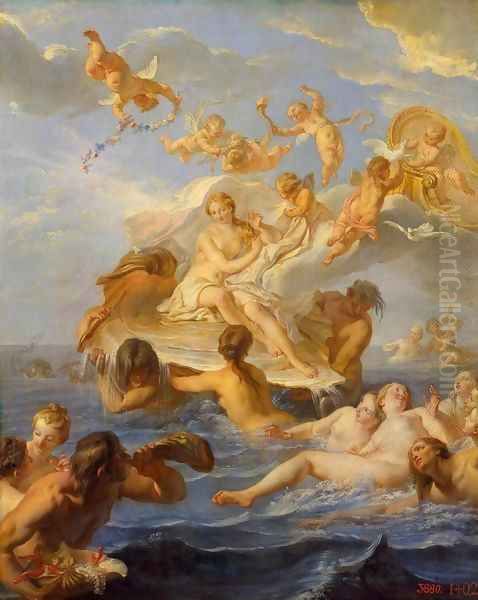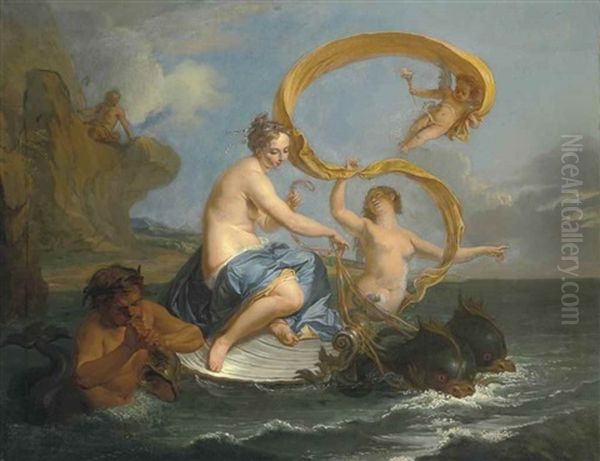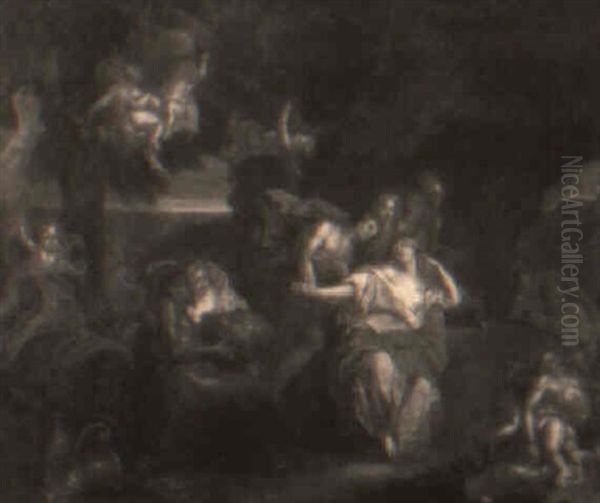
Noël-Nicolas Coypel, born in Paris on November 17, 1690, and passing away in the same city on December 14, 1734, was a distinguished French painter whose career, though tragically short, left an indelible mark on the Rococo period. He hailed from an illustrious artistic dynasty, a factor that undoubtedly shaped his early exposure and inclination towards the arts. As a key figure operating during the transition from the grandeur of the late Baroque to the more intimate and playful Rococo, Coypel's work embodies the elegance, sensuality, and mythological richness characteristic of his era. His contributions, while sometimes overshadowed by his more famous father and half-brother, are significant for their technical skill, refined aesthetics, and embodiment of the Rococo spirit.
Early Life and Artistic Lineage
The name Coypel resonates deeply within the annals of French art history. Noël-Nicolas was the son of Noël Coypel (1628–1707), a highly respected history painter and a prominent figure in the Académie Royale de Peinture et de Sculpture, who served as its director. His elder half-brother, Antoine Coypel (1661–1722), was also a celebrated painter, achieving the prestigious position of Premier Peintre du Roi (First Painter to the King) and director of the Académie. Furthermore, his nephew, Charles-Antoine Coypel (1694–1752), son of Antoine, continued the family tradition, also becoming First Painter to the King and a notable playwright.
Growing up in such an environment, Noël-Nicolas was immersed in art from his earliest years. He received his initial training from his father, benefiting from the rigorous academic principles that Noël Coypel espoused. This foundational education would have included drawing from casts, studying the works of Old Masters, and understanding the principles of composition and perspective. The artistic discussions and the presence of ongoing commissions within the family studio would have provided an unparalleled learning environment.

Despite the strong Baroque influence of his father, Noël-Nicolas developed a style that leaned more towards the emerging Rococo aesthetic. This was a period of significant cultural shift in France. Following the death of Louis XIV in 1715, the solemnity and grandeur of the late Baroque began to give way to a lighter, more intimate, and decorative style, reflecting the tastes of the aristocracy during the Régence and the subsequent reign of Louis XV.
The Emergence of a Rococo Sensibility
Noël-Nicolas Coypel's artistic style is firmly rooted in the Rococo movement, which flourished in France during the first half of the 18th century. This style was characterized by its emphasis on grace, charm, and a certain playful eroticism. Unlike the dramatic intensity and monumental scale often found in Baroque art, Rococo favored more intimate scenes, delicate color palettes, and sinuous, asymmetrical compositions.
Coypel's paintings often feature mythological and allegorical subjects, which were popular themes during the Rococo period. These narratives provided ample opportunity to depict idealized figures, lush landscapes, and scenes of love and pleasure. His works are distinguished by their refined execution, soft modeling of forms, and a harmonious use of color, often favoring pastel shades and luminous tones. There is a palpable sense of elegance and sophistication in his figures, which are typically slender and graceful, embodying the Rococo ideal of beauty.
His compositions are carefully balanced, yet they possess a dynamic quality achieved through flowing lines and a sense of movement. He demonstrated a keen understanding of anatomy and a remarkable ability to render textures, from the softness of flesh to the sheen of silk. While his father, Noël Coypel, was a stalwart of the academic tradition influenced by Nicolas Poussin and Charles Le Brun, Noël-Nicolas embraced a more sensuous and decorative approach, aligning him more closely with contemporaries who were shaping the Rococo style.
Principal Works and Thematic Concerns
Though his career was cut short by his early death at the age of 44, Noël-Nicolas Coypel produced a number of significant works that showcase his talent and his contribution to Rococo art. Among his most celebrated paintings are those that explore mythological themes, allowing for a display of sensuous figures and intricate compositions.

One of his most famous works is The Abduction of Europa (L'enlèvement d'Europe), completed in 1727 and now housed in the Philadelphia Museum of Art. This painting depicts the classical myth where Jupiter, disguised as a white bull, carries away the Phoenician princess Europa. Coypel masterfully captures the dynamism of the scene, with Europa's attendants expressing alarm on the shore while she is borne across the waves. The figures are rendered with a characteristic Rococo elegance, and the color palette is rich yet delicate. The composition is fluid, guiding the viewer's eye through the narrative with grace.
Another notable work is The Alliance of Bacchus and Venus (or The Union of Bacchus and Venus), which exemplifies the Rococo fascination with themes of love and pleasure. Such mythological allegories allowed artists to explore sensual themes under a classical guise. Coypel's treatment of these subjects is marked by a refined sensuality rather than overt eroticism, maintaining an air of decorum and elegance.
His Birth of Venus is another key piece, treating a subject beloved by artists for centuries. Coypel’s interpretation would have focused on the grace and beauty of the goddess, surrounded by attendant figures, all rendered with the characteristic lightness and charm of the Rococo. These mythological scenes were not merely decorative; they often carried allegorical meanings related to love, beauty, and the pleasures of life, resonating with the tastes of the aristocratic patrons of the era.
The painting Roman Charity (La Charité romaine), dated by some sources to 1735 (though this date is problematic given his death in December 1734, perhaps referring to an engraving or a posthumous record), depicts the story of Cimon and Pero. This subject, drawn from Valerius Maximus, tells of a daughter, Pero, who secretly breastfeeds her starving father, Cimon, who has been condemned to death by starvation in prison. While a more somber theme than many Rococo subjects, it was a popular story illustrating filial piety. Coypel’s handling of such a theme would likely have balanced the dramatic potential with a sense of classical restraint and emotional sensitivity.
His oeuvre also included religious subjects, though he is perhaps less known for these than his mythological paintings. The artistic training of the period mandated proficiency in all genres, including history and religious painting, which were considered the highest forms of art.
The Coypel Dynasty: A Family of Artists

Understanding Noël-Nicolas Coypel requires acknowledging the profound influence of his artistic family. His father, Noël Coypel, was a towering figure of the French Baroque. Born in 1628, Noël Coypel rose through the ranks of the Académie Royale, becoming its director in 1695. He was heavily involved in major decorative schemes for the French crown, including works at the Tuileries Palace, the Palace of Versailles (such as the ceiling of the Queen's Guard Room), and the Invalides. His style was classical and monumental, influenced by Poussin and the Roman school. He also served as director of the French Academy in Rome from 1672 to 1675, a testament to his standing.
Noël-Nicolas's elder half-brother, Antoine Coypel, was even more famous in his time. Antoine skillfully navigated the transition from the grand style of Louis XIV to the more intimate art of the early 18th century. He studied under his father and accompanied him to Rome. Antoine's work shows a greater dynamism and coloristic richness than his father's, influenced by Correggio and the Venetian masters, as well as by Peter Paul Rubens. He was a favorite of Philippe II, Duke of Orléans (the Regent), and was appointed Premier Peintre du Roi in 1716. His works, such as the ceiling of the Royal Chapel at Versailles, demonstrate a blend of Baroque grandeur with an emerging Rococo sensibility.
The artistic environment created by Noël and Antoine Coypel provided Noël-Nicolas with both a rich heritage and a formidable standard to live up to. While he learned from their academic rigor and technical mastery, he carved out his own niche within the Rococo style, which was more fully developed during his active years than during Antoine's peak. His style is generally considered lighter and more purely Rococo than that of Antoine, who retained more Baroque elements.
The next generation was represented by Charles-Antoine Coypel, Antoine's son and Noël-Nicolas's nephew. Charles-Antoine also became Premier Peintre du Roi and was a prolific painter of historical and mythological scenes, as well as portraits and genre scenes. He was also known for his writings on art and his plays. The Coypel dynasty thus spanned several generations, each member contributing to the evolution of French art from the high Baroque through the Rococo.
Interactions with Contemporary Painters and the Parisian Art World

The Parisian art world in the early 18th century was a vibrant and competitive milieu. Noël-Nicolas Coypel was an active participant in this world, primarily through his involvement with the Académie Royale de Peinture et de Sculpture. He was received (agréé) into the Académie in 1716 and became a full member (reçu) in 1720 with his painting Neptune Abducting Amymone. In 1733, he was appointed as a professor at the Académie, a position that recognized his skill and standing among his peers.
His contemporaries included some of the most famous names of the Rococo period. Jean-Antoine Watteau (1684–1721), though his career was tragically short like Coypel's, was a seminal figure in the development of Rococo, particularly known for his fêtes galantes – scenes of elegant outdoor entertainments. Watteau's delicate touch, melancholic charm, and poetic sensibility had a profound impact on the art of the era.
François Lemoyne (1688–1737) was another significant contemporary, a history painter whose style bridged the late Baroque and early Rococo. Lemoyne was known for large-scale decorative works, such as the ceiling of the Salon d'Hercule at Versailles. He was also the teacher of two other leading Rococo painters, François Boucher and Charles-Joseph Natoire.
François Boucher (1703–1770) would become one of the most emblematic painters of the Rococo style, known for his sensuous mythological scenes, pastoral landscapes, and portraits. Though younger than Noël-Nicolas, Boucher's career was just beginning to take off as Coypel's was ending. Boucher's art, with its emphasis on charm, eroticism, and decorative flair, came to define the high Rococo under Madame de Pompadour's patronage.
Charles-Joseph Natoire (1700–1777) was a rival of Boucher and another prominent Rococo painter. He produced numerous mythological and historical paintings, as well as designs for tapestries. His style was elegant and decorative, similar in spirit to Coypel's, though Natoire lived much longer and had a more extensive career, eventually becoming director of the French Academy in Rome.
Other notable painters of the period included Nicolas Lancret (1690–1743), a follower of Watteau known for his charming fêtes galantes, and Jean-Baptiste Pater (1695–1736), another imitator of Watteau. Jean-Marc Nattier (1685–1766) specialized in elegant portraits, often depicting court ladies in mythological guise. Jean-Baptiste Oudry (1686–1755) was renowned for his animal paintings, hunting scenes, and still lifes, as well as his role as director of the Beauvais and Gobelins tapestry manufactories.
In contrast to the prevailing Rococo taste, Jean-Baptiste-Siméon Chardin (1699–1779) focused on still lifes and quiet genre scenes of domestic life, rendered with profound sensitivity and masterful technique. His work offered a more sober and introspective alternative to the exuberance of much Rococo art.

The influence of earlier masters was also palpable. The colorism and dynamism of Peter Paul Rubens continued to inspire, as did the sensuousness of Venetian painters like Titian and Veronese. Within the French tradition, the classical principles of Nicolas Poussin and the decorative grandeur of Charles Le Brun still formed the bedrock of academic training, even as artists adapted these influences to the changing tastes of the 18th century. Hyacinthe Rigaud (1659-1743) and Nicolas de Largillière (1656-1746), though primarily portraitists rooted in the Baroque tradition, continued to be highly active and influential during Noël-Nicolas's lifetime, representing the established order.
Noël-Nicolas Coypel would have interacted with many of these artists through the Académie, participating in its exhibitions (the Salons) and its internal affairs. The Salons were crucial for artists to display their work to the public and attract patronage.
Academic Career and Teaching
Noël-Nicolas Coypel's appointment as a professor at the Académie Royale in 1733 was a significant achievement. The role of professor involved teaching younger artists, delivering lectures, and participating in the governance of the institution. This position indicates that his skills and knowledge were highly regarded by his peers. His teaching would have emphasized the academic principles of drawing, composition, and the study of classical art and nature, filtered through his own Rococo sensibility.
The Académie was the central institution governing the arts in France. It controlled training, exhibitions, and artistic standards. Membership and academic positions were highly sought after, as they conferred prestige and access to royal and aristocratic commissions. Coypel's progression within the Académie, from student to member to professor, demonstrates a successful academic career, albeit one cut short.
The provided text confusingly attributes a directorship of the French Academy in Rome in 1672 to Noël-Nicolas, which is incorrect as he was not yet born; this refers to his father, Noël Coypel. Similarly, anecdotes about leading students on art tours to Italy are more likely attributable to his father or other directors of the Rome academy. Noël-Nicolas's own career was primarily Paris-based.
Legacy and Art Historical Evaluation
Noël-Nicolas Coypel's early death at 44 undoubtedly limited his output and perhaps his ultimate fame compared to contemporaries like Boucher or Watteau, or indeed his own long-lived father and highly successful half-brother. However, his surviving works are of high quality and are representative of the best of French Rococo painting.
He is appreciated for his elegant draftsmanship, harmonious color palettes, and graceful compositions. His mythological paintings, in particular, capture the lightheartedness and sensuality of the Rococo spirit. While he may not have been a radical innovator, he was a master of his craft who skillfully synthesized the artistic currents of his time.
His influence on subsequent artists is perhaps more subtle than that of more dominant figures. However, as a professor at the Académie, he would have directly influenced a generation of students. His work contributed to the overall development and dissemination of the Rococo style in France.
Art historians place Noël-Nicolas Coypel as a significant, if not leading, figure of the French Rococo. His paintings are found in major museum collections, and they continue to be admired for their charm and technical excellence. He successfully navigated the legacy of his famous family, developing his own distinct artistic voice that resonated with the tastes of his era. His work serves as a fine example of the refinement and elegance that characterized French art in the early 18th century, a period of remarkable artistic creativity and cultural brilliance.
The confusion in some historical accounts between Noël-Nicolas and his father, Noël Coypel, or even his half-brother Antoine, highlights the complexities of studying artistic dynasties. It is crucial to distinguish their individual contributions. Noël Coypel was a master of the French Baroque, a classicist in the tradition of Poussin. Antoine Coypel represented a transition, blending Baroque grandeur with a more dynamic and coloristic approach. Noël-Nicolas, on the other hand, was more purely a painter of the Rococo, his style characterized by a greater lightness, intimacy, and decorative grace than that of his predecessors in the family.
Existing Works and Their Dispersal
Works by Noël-Nicolas Coypel are held in various public and private collections, primarily in France and the United States. For instance, the Philadelphia Museum of Art holds his Abduction of Europa. French provincial museums, as well as the Louvre in Paris, are likely to have examples of his work or drawings.
The provided text mentions a 2023 exhibition at Versailles featuring "Coypel" (likely referring to the broader family, or perhaps Noël Coypel given the Baroque context of Versailles decorations). It also mentions a work, Assumption of the Virgin, by "Coypel" exhibited at the Luxembourg Palace, and an exhibition at the Musée de l'École de Peinture et de Sculpture. Without more specific attribution, it's hard to tie these directly to Noël-Nicolas alone, as "Coypel" exhibitions often encompass the entire dynasty. However, any comprehensive showing of the Coypel family's art would certainly include significant pieces by Noël-Nicolas.
His paintings, like those of many Rococo artists, were often intended for specific decorative contexts within aristocratic homes, serving as overdoors, or parts of larger decorative ensembles. This integration into interior design was a hallmark of the Rococo period, where art, architecture, and furnishings were conceived as a harmonious whole.
Conclusion: A Refined Voice in the Rococo Symphony
Noël-Nicolas Coypel stands as a testament to the artistic vibrancy of early 18th-century France. Born into a family that was a veritable institution in French art, he absorbed the lessons of the past while embracing the new aesthetic sensibilities of the Rococo. His paintings, characterized by their elegance, refined sensuality, and mythological charm, contribute a distinct voice to the chorus of Rococo masters.
Though his life and career were relatively brief, the quality of his work secured him a place in the Académie Royale and the esteem of his contemporaries. He masterfully depicted the popular mythological themes of his day, infusing them with a grace and lightness that perfectly captured the spirit of the age. While the names of Watteau, Boucher, or Fragonard might loom larger in popular consciousness of the Rococo, Noël-Nicolas Coypel was a significant talent whose art continues to delight and impress. He remains an important figure for understanding the nuances of the Rococo style and the rich artistic heritage of the Coypel dynasty, a family that significantly shaped the course of French painting for nearly a century. His legacy is one of refined craftsmanship and an enduring contribution to the elegant and pleasure-loving world of Rococo art.